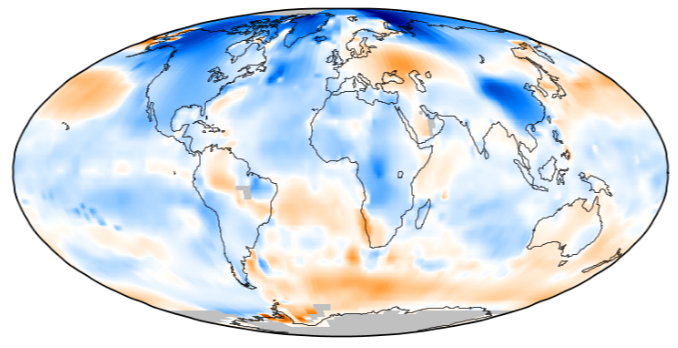
Global warming “hockey stick” data founded on FRAUD… computer models “hacked” to produce warming trend from any data set
Sunday, June 04, 2017 by Mike Adams
http://www.suppressed.news/2017-06-04-global-warming-hockey-stick-data-founded-fraud-computer-models-hacked-to-produce-warming-trend-from-any-data-set.html

“The hockey stick debate is thus about two things. At a technical level it is about flaws in methodology and erroneous results in a scientific paper. But at a political level, the debate is about whether the IPCC betrayed the trust of governments around the world.” – Professor Ross McKitrick, 2005
In late 2016, the liberal media launched a conspiracy theory narrative that claimed “the Russians stole the election from Hillary Clinton.” This was achieved, we were told without a single shred of supporting evidence, by hacking the DNC emails and publicizing the highly embarrassing messages that revealed just how corrupt and criminal the DNC has been all along. That hacking, we’ve been informed, was very real and very scary, and it’s why the entire left-wing media continues to insist to this day that the election was a fraud.
The “Russian conspiracy theory” is, of course, complete fiction. It was fabricated by the left-wing media as cover for Hillary Clinton’s dismal candidate performance and horrendous loss to a total political outsider. The Russian conspiracy narrative, in fact, wasn’t spawned until the days after Clinton’s loss, and it was just a few weeks earlier that Hillary Clinton herself had condemned Donald Trump for refusing to pre-accept the outcome of the election, even before the election took place. Clinton said she “feared for our democracy” and shuddered at the thought that someone wouldn’t agree in advance to honor the outcome of an election the lawless Left was systematically stealing through vote fraud, rigged CNN debate questions and an all-out media smear campaign to destroy the reputation of Trump.
The 2016 wasn’t hacked; it was lost by Hillary Clinton. But there is some real hacking that has been going on to steal national sovereignty and overthrow national governments. That hacking, it turns out, was conducted on a piece of software to make it produce false “hockey stick” graphs depicting global warming out of data sets that logically support no such conclusion.
Hacking the IPCC global warming data
The same left-wing media outlets that fabricated the “Russian hacking” conspiracy, curiously, have remained totally silent about a real, legitimate hacking that took place almost two decades earlier. The IPCC “global warming” software models, we now know, were “hacked” from the very beginning, programmed to falsely produce “hockey stick” visuals from almost any data set… include “random noise” data.
What follows are selected paragraphs from a fascinating book that investigated this vast political and scientific fraud: The Real Global Warming Disaster by Christopher Booker (Continuum, 2009). This book is also available as an audio book from Audible.com, so if you enjoy audio books, download a copy there.
Here’s what Booker found when he investigated the “hacking” of the temperature data computer models:
From “The Real Global Warming Disaster” by Christopher Booker: (bold emphasis added)
Nothing alerted us more to the curious nature of the global warming scare than the peculiar tactics used by the IPCC to promote its orthodoxy, brooking no dissent. More than once in its series of mammoth reports, the IPCC had been caught out in very serious attempts to rewrite the scientific evidence. The most notorious instance of this was the extraordinary prominence it gave in 2001 to the so-called ‘hockey stick’ graph, mysteriously produced by a relatively unknown young US scientist, which completely redrew the accepted historical record by purporting to show temperatures in the late twentieth century having shot upwards to a level far higher than had ever been known before. Although the ‘hockey stick’ was instantly made the central icon of the IPCC’s cause, it was within a few years to become one of the most comprehensively discredited artefacts in the history of science.
Similarly called into serious doubt was the reliability of some of the other temperature figures on which the IPCC based its case. Most notably these included those provided by NASA’s Goddard Institute for Space Studies (GISS), run by Dr James Hansen, A1 Gore’s closest scientific ally, which were one of the four official sources of temperature data on which the IPCC relied. These were shown to have been repeatedly ‘adjusted’, to suggest that temperatures had risen further and more steeply than was indicated by any of the other three main data-sources.
…Out of the blue in 1998 Britain’s leading science journal Nature, long supportive of the warming orthodoxy, published a new paper on global temperature changes over the previous 600 years, back to 1400. Its chief author was Michael Mann, a young physicist-turned-climate scientist at the University of Massachusetts, who had only completed his PhD two years before. In 1999 he and his colleagues published a further paper, based only on North America but extending their original findings over 1000 years.
Their computer model had enabled them to produce a new temperature graph quite unlike anything seen before. Instead of the previously familiar rises and falls, this showed the trend of average temperatures having gently declined through nine centuries, but then suddenly shooting up in the twentieth century to a level that was quite unprecedented.
In Mann’s graph such familiar features as the Mediaeval Warm Period and the Little Ice Age had simply vanished. All those awkward anomalies were shown as having been illusory. The only real anomaly which emerged from their studies was that sudden exponential rise appearing in the twentieth century, culminating in the ‘warmest year of the millennium’, 1998.
As would eventually emerge, there were several very odd features about Mann’s new graph, soon to be known as the ‘hockey stick’ because its shape, a long flattish line curving up sharply at the end, was reminiscent of the stick used in ice hockey. But initially none might have seemed odder than the speed with which this obscure study by a comparatively unknown young scientist came to be taken up as the new ‘orthodoxy’.
So radically did the ‘hockey stick’ rewrite all the accepted versions of climate history that initially it carried all before it, leaving knowledgeable experts stunned. It was not yet clear quite how Mann had arrived at his remarkable conclusions, precisely what data he had used or what methods the IPCC had used to verify his findings. The sensational new graph which the IPCC made the centrepiece of its report had been sprung on the world out of left field.
…Yet when, over the years that followed, a number of experts from different fields began to subject Mann’s two papers to careful analysis, some rather serious questions came to be asked about the basis for his study.
For a start, although Mann and his colleagues had cited other evidence for their computer modelling of historical temperatures, it became apparent that they had leaned particularly heavily on ‘proxy data’ provided by a study five years earlier of tree-rings in ancient bristlecone pine trees growing on the slopes of California’s Sierra Nevada mountains. ‘Proxies’ used to calculate temperature consist of data other than direct measurement, such as tree rings, stalactites, ice cores or lake sediments.
According to the 1993 paper used by Mann, these bristlecone pines had shown significantly accelerated growth in the years after 1900. But the purpose of this original study had not been to research into past temperatures. As was made clear by its title – ‘Detecting the aerial fertilisation effect of atmospheric C02 enrichment in tree-ring chronologies’ – it had been to measure the effect on the trees’ growth rate of the twentieth-century increase in C02 levels.
Tree rings are a notoriously unreliable reflector of temperature changes, because they are chiefly formed during only one short period of the year, and cannot therefore give a full picture. This 1993 study of one group of trees in one untypical corner of the US seemed a remarkably flimsy basis on which to base an estimate of global temperatures going back 1000 years.
Then it transpired that, in order to show the twentieth-century section of the graph, the terrifying upward flick of temperatures at the end of the ‘hockey stick’, spliced in with the tree-ring data had been a set of twentieth-century temperature readings, as recorded by more than 2,000 weather stations across the earth’s surface. It was these which more than anything helped to confirm the most dramatic conclusion of the study, that temperatures in the closing decades of the twentieth century had been shooting up to levels unprecedented in the history of the last 1,000 years, culminating in the ‘warmest year of the millennium’, 1998.
Not only was it far from clear that, for this all-important part of the graph, two quite different sets of data had been used. Also accepted without qualification was the accuracy of these twentieth-century surface temperature readings. But the picture given by these was already being questioned by many expert scientists who pointed to evidence that readings from surface weather stations could become seriously distorted by what was known as the ‘urban heat island effect’. The majority of the thermometers in such stations were in the proximity of large and increasingly built-up population centres. It was well-established that these heated up the atmosphere around them to a significantly higher level than in more isolated locations.
Nowhere was this better illustrated than by contrasting the temperature readings taken on the earth’s surface with those which, since 1979, had been taken by NASA satellites and weather balloons, using a method developed by Dr Roy Spencer, responsible for climate studies at NASA’s Marshall Space Centre, and Dr John Christie of the University of Alabama, Huntsville.
Surprisingly, these atmospheric measurements showed that, far from warming in the last two decades of the twentieth century, global temperatures had in fact slightly cooled. As Spencer was at pains to point out, these avoided the distortions created in surface readings by the urban heat island effect. The reluctance of the IPCC to take proper account of this, he observed, confirmed the suspicion of ‘many scientists involved in the process’ that the IPCC’s stance on global warming was ‘guided more by policymakers and politicians than by scientists’.
What was also remarkable about the ‘hockey stick’, as was again widely observed, was how it contradicted all that mass of evidence which supported the generally accepted picture of temperature fluctuations in past centuries. As was pointed out, tree-rings are not the most reliable guide to assessing past temperatures. Scores of more direct sources of proxy evidence had been studied over the years, from Africa, South America, Australia, Pakistan, Antarctica, every continent and ocean of the world.
Whether evidence was taken from lake sediments or ice cores, glaciers in the Andes or boreholes in every continent (Huang et ai, 1997), the results had been remarkably consistent in confirming that the familiar view was right. There had been a Little Ice Age, across the world. There had similarly been a Mediaeval Warm Period. Furthermore, a mass of data confirmed that the world had been even warmer in the Middle Ages than it was in 1998.
The first comprehensive study to review this point was published in January 2003 by Dr Willie Soon and his colleague Dr Sallie Baliunas of the Harvard-Smithsonian Center for Astrophysics. They had examined 140 expert studies of the climate history of the past 1,000 years, based on every kind of data. Some had given their findings only in a local or regional context, others had attempted to give a worldwide picture. But between them these studies had covered every continent. The question the two researchers had asked of every study was whether or not it showed a ‘discernible climate anomaly’ at the time of (1) the Little Ice Age and (2) the Mediaeval Warm Period; and (3) whether it had shown the twentieth century to be the warmest time in the Millennium.
Their conclusion was unequivocal. Only two of the studies they looked at had not found evidence for the Little Ice Age. Only seven of the 140 studies had denied the existence of a Mediaeval Warm Period, while 116 had confirmed it.
On the crucial question of whether or not the twentieth century had been the warmest of the past thousand years, only 15 studies, including that of Mann himself, had unambiguously agreed that it was. The vast majority accepted that earlier centuries had been warmer. The conclusion of Soon and Baliunas was that ‘Across the world, many records reveal that the twentieth century is probably not the warmest nor a uniquely extreme climatic period of the last millennium.’
But if Mann and his colleagues had got the picture as wrong as this survey of the literature suggested, nothing did more to expose just how this might have come about than a remarkable feat of analysis carried out later in the same year by two Canadians and published in October 2003. (S. McIntyre and R. McKitrick, 2003, ‘Corrections to the Mann et al. (1998) proxy databse and northern hemispheric average temperature series’, Energy and Environment, 14, 752-771. In the analysis of McIntyre and McKitrick’s work which follows, reference will also be made to their later paper, McIntyre and McKitrick, 2005b, ‘The M & M critique of the MBH98 Northern Hemisphere climate index, Update and applications’, Energy and Environment, 16, 69-99, and also to McKitrick (2005), ‘What is the “Hockey Stick” debate about?’, op. cit.)
Stephen McIntyre, who began their study, was a financial consultant and statistical analyst specialising in the minerals industry, and was later joined by Ross McKitrick, a professor of economics at Guelph University. Neither made any pretensions to being a climate scientist, but where they did have considerable expertise was in knowing how computers could be used to play around with statistics. They were also wearily familiar with people using hockey sticklike curves, showing an exaggerated upward rise at the end, to sell a business prospect or to ‘prove’ some tendentious point.
Intrigued by the shape of the IPCC’s now famous ‘hockey stick’ graph, in the spring of 2003 McIntyre approached Mann and his colleagues to ask for a look at their original data set. ‘After some delay’, Mann ‘arranged provision of a file which was represented as the one used’ for his paper. But it turned out not to include ‘most of the computer code used to produce their results’. This suggested to McIntyre, who was joined later that summer by McKitrick, that no one else had previously asked to examine it, as should have been required both by peer-reviewers for the paper published in Nature and, above all, by the IPCC itself. (This account of the ‘hockey stick’ saga is based on several sources, in particular Ross McKitrick’s paper already cited , ‘What is the “hockey stick” debate about?’ (2005), and his evidence to the House of Lords Committee on Economic Affairs, ‘The Economics of Climate Change’, Vol. II, Evidence, 2005. See also David Holland, ‘Bias and concealment in the IPCC Process: the “Hockey Stick” affair and its implications’ (2007), op. cit.)
When McIntyre fed the data into his own computer, he found that it did not produce the claimed results. At the heart of the problem was what is known as ‘principal component analysis’, a technique used by computer analysts to handle a large mass of data by averaging out its components, weighting them by their relative significance.
One of the first things McIntyre had discovered was that the ‘principal component analysis’ used by Mann could not be replicated. ‘In the process of looking up all the data sources and rebuilding Mann’s data set from scratch’, he discovered ‘quite a few errors concerning location labels, use of obsolete editions, unexplained truncations of various series etc.’ (for instance, data reported to be from Boston, Mass., turned out to be from Paris, France, Central England temperature data had been truncated to leave out its coldest period, and so forth).
But the real problem lay with the ‘principal component analysis’ itself. It turned out that an algorithm had been programmed into Mann’s computer model which ‘mined’ for hockey stick shapes whatever data was fed into it. As McKitrick was later to explain, ‘had the IPCC actually done the kind of rigorous review that they boast of they would have discovered that there was an error in a routine calculation step (principal component analysis) that falsely identified a hockey stick shape as the dominant pattern in the data. The flawed computer program can even pull out spurious hockey stick shapes from lists of trendless random numbers. ’ (McKitrick, House of Lords evidence, op. cit.)
Using Mann’s algorithm, the two men fed a pile of random and meaningless data (‘red noise’) into the computer 10,000 times. More than 99 per cent of the time the graph which emerged bore a ‘hockey stick’ shape. They found that their replication of Mann’s method failed ‘all basic tests of statistical significance’.
When they ran the programme again properly, however, keeping the rest of Mann’s data but removing the bristlecone pine figures on which he had so heavily relied, they found that the Mediaeval Warming once again unmistakably emerged. Indeed their ‘major finding’, according to McKitrick, was that Mann’s own data confirmed that the warming in the fifteenth century exceeded anything in the twentieth century.44
One example of how this worked they later quoted was based on comparing two sets of data used by Mann for his second 1999 paper, confined to proxy data from North America. One was drawn from bristlecone pines in western North America, the other from a tree ring chronology in Arkansas. In their raw state, the Californian series showed a ‘hockey stick’ shape; the other, typical of most North American tree ring series, showed an irregular but basically flat line with no final upward spurt. When these were put together, however, the algorithm emphasised the twentieth-century rise by giving ‘390 times as much weight’ to the bristlecone pines as to the trees from Arkansas.45
In other words, although Mann had used hundreds of tree ring proxies from all over North America, most showing a flattish line like that from Arkansas, the PCAs used to determine their relative significance had given enormously greater weight to those Californian bristlecones with their anomalous ‘hockey stick’ pattern.
Furthermore, McIntyre and McKitrick found that Mann had been well aware that by removing the bristlecone pine data the ‘hockey stick’ shape of his graph would vanish, because he had tried it himself. One of the files they obtained from him showed the results of his own attempt to do this. The file was marked ‘Censored’ and its findings were nowhere mentioned in the published study.
What, however, concerned McIntyre and McKitrick as much as anything else about this extraordinary affair was what it revealed about the methods of the IPCC itself. Why had it not subjected Mann’s study to the kind of basic professional checks which they themselves had been able to carry out, with such devastating results?
Furthermore, having failed to exercise any proper quality control, why had those at the top of the IPCC then gone out of their way to give such extraordinary prominence to ‘the hockey stick data as the canonical representation of the earth’s climate history. Due to a combination of mathematical error and a dysfunctional review process, they ended up promoting the exact wrong conclusion. How did they make such a blunder?’
Continue reading The Real Global Warming Disaster by Christopher Booker (Continuum, 2009), available at BN.com, Amazon.com and Audible.com.
Conclusion: The global warming “hockey stick” is SCIENCE FRAUD
What all this reveals, of course, is that the global warming “hockey stick” is fake science. As Booker documents in his book, data were truncated (cut off) and software algorithms were altered to produce a hockey stick trend out of almost any data set, including random noise data. To call climate change “science” is to admit your own gullibility to science fraud.
The IPCC, it turns out, used science fraud to promote global warming and “climate change” narratives, hoping no one would notice that the entire software model was essentially HACKED from the very beginning, deliberately engineered to produce the alarming temperature trend the world’s bureaucrats wanted so they could terrorize the world into compliance with climate change narratives.
The Russians didn’t hack the 2016 election, in case you were wondering. But dishonest scientists really did hack the global warming modeling software to deceive the entire world and launch a whole new brand of climate change fascism that has now infected the minds of hundreds of millions of people across the planet. Everything they’ve been told about climate change, it turns, out, was all based on a software hack.
Tagged Under: Tags: climate change, computer data, global warming, Hacked, hockey stick, IPCC, science fraud





